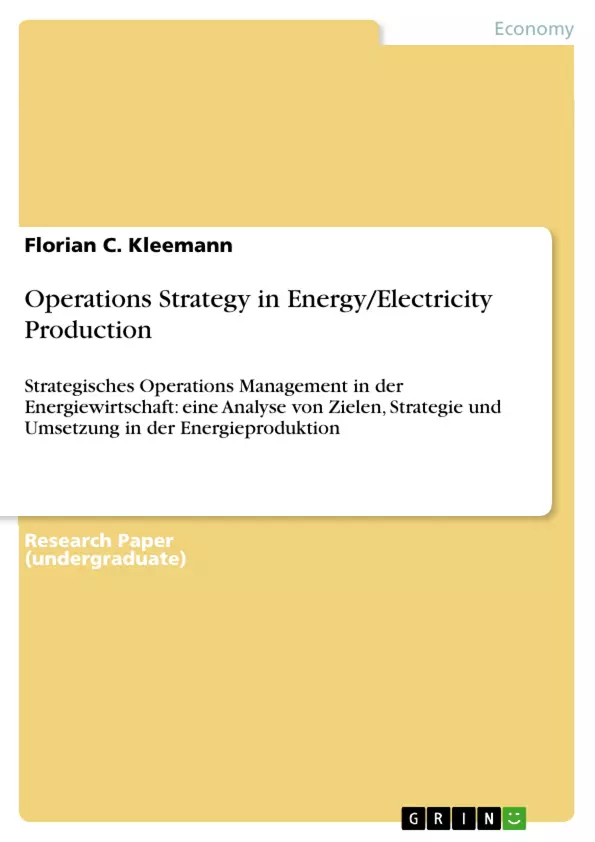Die Arbeit analysiert anhand eines realen, anonymisierten Fallbeispiels aus der Energierzeugung die Besonderheiten der Operations-Strategie in der Elektrizitätswirtschaft. Anhand eines konzeptionellen Modells der Produktionsstrategie erfolgt eine Analyse des Ist-Standes, ein Abgleich mit dem Soll-Zustand (Fit Gap) und daraus die Entwicklung von Handlungsempfehlungen. Die Betrachtung erfolgt anhand interner und externer Einflussfaktoren sowie aus Sicht der Unternehmens- und Produktionsstrategie. Dabei wird besonderes Augenmerk auf die Besonderheiten der Energiewirtschaft gelegt. Da in diesem Gebiet kaum betriebswirtschaftliche Arbeiten bestehen, leitet die Arbeit einen wesentlichen Beitrag zu dieser Perspektive für die Energiewirtschaft.
Inhaltsverzeichnis (Table of Contents)
- Introduction
- Operations strategy at EXAMPLE Power
- Internal perspective – resources-based perspective
- External perspective – market-based-perspective
- Hierarchical perspective: top-down vs. bottom up
- Performance improvement of the EXAMPLE Power operations strategy
- Performance issue 1: strategic investments
- Performance issue 2: renewable generation technology
- Performance issue 3: supply network strategy
- Strategic Performance Management
- Conclusion
Zielsetzung und Themenschwerpunkte (Objectives and Key Themes)
This report aims to analyze the operations strategy of EXAMPLE Power, an electricity generating company, to identify performance gaps and recommend actions to close them. The analysis uses the “operations strategy matrix” to evaluate the internal and external perspectives of EXAMPLE's strategy, as well as its hierarchical perspective. It aims to provide a comprehensive overview of the company's operations strategy, identify areas for improvement, and suggest actionable solutions to enhance performance.
- Internal perspective: capacity, supply networks, technology, and development
- External perspective: market requirements (dependability, cost, quality, etc.)
- Hierarchical perspective: corporate strategy vs. operational business
- Strategic performance gaps and potential solutions
- Holistic approach to strategy development, implementation, and measurement
Zusammenfassung der Kapitel (Chapter Summaries)
The report begins by introducing the concept of operations strategy and its importance in modern business, particularly in the energy sector. It then delves into an analysis of EXAMPLE Power's operations strategy, examining its internal and external perspectives as well as the hierarchical relationship between corporate strategy and operational execution. The report highlights the significant influence of the internal, resource-based view on EXAMPLE's operations strategy due to the nature of the product (electricity) and the associated transformation process. However, it recognizes the growing importance of the external perspective as customer expectations evolve. The report acknowledges that EXAMPLE's production process maturity has led to corporate strategy dominating the operations strategy rather than a “bottom-up perspective.”
The analysis then focuses on specific performance gaps within EXAMPLE's operations strategy, covering key issues such as strategic investments, renewable generation technology, and supply network strategy. The report explores potential solutions for each of these issues, including investment strategies, technology adoption, and supply network optimization. It also emphasizes the importance of Strategic Performance Management in ensuring successful implementation of these measures. Finally, the report recommends a shift in how strategy is created, implemented, and updated at EXAMPLE, advocating for a more holistic and integrated approach to measuring strategy success.
Schlüsselwörter (Keywords)
This report explores the critical topics of operations management, energy generation, the energy industry, electricity production, strategic analysis, performance gaps, and the strategic performance management framework. The analysis draws upon a resource-based perspective, examining internal factors such as capacity, supply networks, technology, and development, alongside external perspectives encompassing market requirements like dependability, cost, and quality. The report further investigates the interplay between corporate strategy and operational business, examining how they shape the operations strategy within the context of the energy industry. This analysis delves into key performance issues, such as strategic investment, renewable generation technology, and supply network strategies, offering potential solutions and actionable recommendations.
- Quote paper
- Florian C. Kleemann (Author), 2010, Operations Strategy in Energy/Electricity Production, Munich, GRIN Verlag, https://www.grin.com/document/190100



